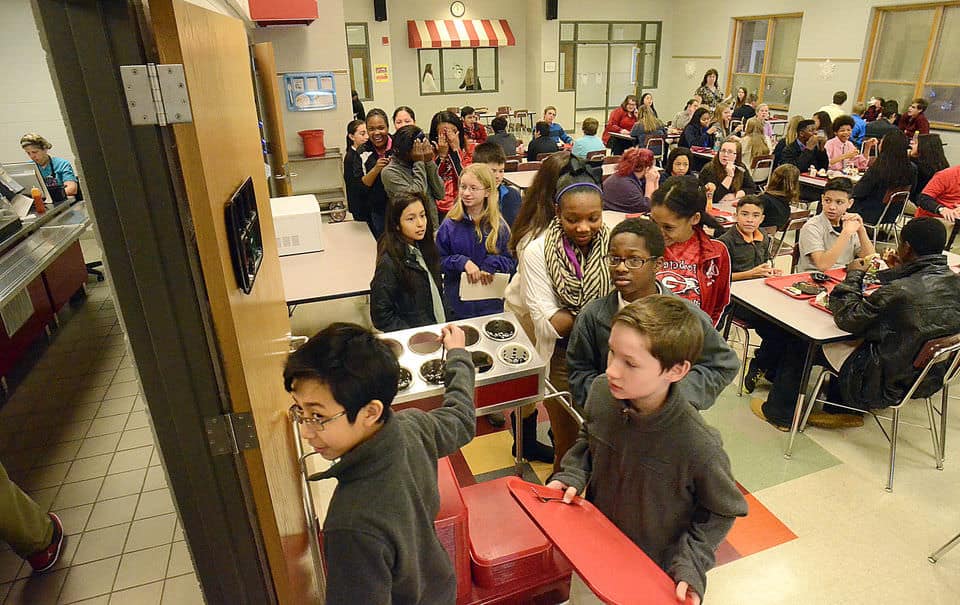
This article was originally published in the Hickory Daily Record on March 2, 2015.
In the cafeteria at Newton-Conover High School, nutrition director Jill Gobin surveyed the room with a watchful eye.
She wasn’t sure about the new whole grain rolls this year, she explained. They couldn’t get them to rise properly.
“They’re like hockey pucks,” Gobin said.
True to her word, the rolls sat on lunch trays, untouched.
Gobin shook her head.
In her office eight miles away, Catawba County Schools nutrition director Valda Robinson explained the hardest food for her to disguise was macaroni and cheese.
“Catawba County has been renowned for their good mac and cheese,” Robinson said with a sigh. “But a brown noodle with yellow cheese – it doesn’t look good.”
Local school nutrition directors aren’t alone. Scenes like these have played out nationwide since the Healthy, Hunger-Free Kids Act in 2010 overhauled school nutrition requirements.
Lunch programs in two local school districts – Catawba County Schools and Hickory Public Schools – have seen declining participation since the rules went into effect.
And CCS, which is the largest of the three and serves an average of 10,000 lunches a day, has lost money three years in a row.
As Congress gears up to reauthorize the new nutrition standards in September, food service directors say they worry about keeping their programs afloat while facing a salvo of new regulations year after year.
Playing catch-up
The regulations came fast and furious.
The Healthy, Hunger-Free Kids Act was signed into law in 2010, but the U.S. Department of Agriculture’s rules didn’t go into effect until the 2012-13 school year. That’s when nutrition directors hit the ground running.
Since then, they haven’t stopped.
“When you think you understand it all, it changes,” Gobin said.
The first year, school meals had to abide by new calorie and trans fats limits as well as bigger portion sizes for fruits and vegetables. In addition, half of the grains served at lunch had to be whole grain-rich.
The year after, in 2013-14, the calorie, trans fats and whole grain-rich requirements took effect for breakfast, too.
The year after that, three new regulations hit.
First, school meals had to go from 50 percent to 100 percent whole grain rich.
Then, Smart Snacks kicked in. A la carte items such as those sold in vending machines now had to meet by several new nutrition standards, including being under 200 calories and having a fruit, vegetable, daily product or protein food as its first ingredient.
Finally, sodium targets were lowered to 1,420 mg per day at lunch.
By next school year, that limit would be lowered even further, to 1,080 mg.
By 2022-23, schools would only be allowed to serve 740 mg of sodium per day.
When one Chick-fil-A chicken sandwich alone contains 1,390 mg of sodium, it’s a daunting task.
“We’re the meanies,” Gobin said. “At the high school, I’m taking out Texas Pete because it’s so high in sodium, and they’re freaking out. A couple years ago, we had to pull the salt shakers. There were petitions that went out. It was crazy.”
School nutrition directors started got more worried when kids started opting out of school lunches.
At both CCS and HPS, participation has dropped about 5 percent since the regulations went into place.
“In the future, if participation continues to drop, it will definitely be a problem,” HPS school nutrition director Rebecca Allen said.
Last year was so hard on school meal programs, N.C. Department of Public Instruction school nutrition chief Lynn Harvey said, the department issued a formal waiver request to USDA.
“The act is welcomed,” Harvey said. “We need reform. I think what happened was that some of the intent translated into some extremes in implementation.”
Across the state, Harvey said the number of school nutrition programs reporting a loss in the first year of the new nutrition standards more than doubled.
Out of 115 district meal programs, the number operating in the red skyrocketed from 35 to 71 in one year.
That number dropped last year – to 64 – but is still higher than before the new nutrition standards took effect.
Harvey said many manufacturers and food vendors weren’t ready for the regulation, driving prices up.
“The higher cost of reformulation of the product – the industry had to turn that around onto their clientele,” Harvey said.
“There were weeks and weeks where we couldn’t get chips, we couldn’t get Doritos, we couldn’t get any of the items we could actually serve because the manufacturers weren’t ready for it,” Gobin said. “They just didn’t have the capacity to create that much demand.”
Allen said that her food costs rose by 8 percent, or about $60,000, the first year regulations went into effect.
The next year, she said food purchases increased another 4 percent.
“It’s great in theory,” Allen said. “I think the negative is that they didn’t look at it from the whole picture of how much it was really going to cost to serve this meal.”
Congress pledged to give an additional 6 cents per lunch to school meal programs meeting the new regulations, in addition to the federal reimbursements USDA already gives. The state didn’t provide any additional money.
It fell on the shoulders of school nutrition directors to keep their meal programs humming while facing rising costs, falling participation and a salvo of new regulations each year.
“These regs have been coming down the pipe year after year,” Robinson said. “You must offer this, you must offer that. But the $3.06 that they’re giving us back for a student, is that covering our student plus our plate cost plus our labor? It isn’t. And that’s how many of us go into the red.”
Health dilemma
School nutrition directors have always had to strike a balance between two things: health and the bottom line.
In the past, school meal programs have often relied on selling a la carte items, which are typically tastier and more expensive, to keep their programs afloat.
The Hickory High School “pizza cart,” for example, was generating $1,000 a day, Allen said. It’s now gone because the pizza and chicken fingers it was selling no longer meet the Smart Snack standards.
It makes sense from a health perspective – but losing that revenue also has an impact on schools’ financial health.
The meal program at CCS, which relies even more on supplemental sales, has seen revenue from a la carte items tumble 23 percent in two years.
CCS’ food program was already in the red when Robinson took the job.
It’s continued to lose money every year as expenditures continue to rise. In 2011-12, the program lost $291,000. The next year, Robinson said their year-end loss was more than $450,000. In the most recent school year, 2013-14, CCS had one of its highest losses ever: nearly $738,000.
In an effort to stem the losses, Robinson said she’s looking at joining the N.C. Procurement Alliance, a group of 92 school districts that send out unified bids to get lower prices. HPS and NCCS are members, while CCS is not.
In addition, Robinson said the program took a “bold step” a year and a half ago to offer fewer entrée options and concentrate on the most popular items – pizza and chicken – in exchange for higher quality.
“Before, we had chicken nuggets that were pressed and formed,” Robinson said. “Now we have a chicken chunk, which is made out of a whole muscle meat, that’s similar to when Johnny goes out to a Chick-fil-A or a Zaxby’s.”
Robinson believes the strategy will improve participation and streamline preparation of the meals.
This year, losses have slowed.
“We’re working our way out of the red,” Robinson said. “But it’s very difficult and many programs are in the red and we’re no different.”
Whether Robinson’s strategy will hold out in the long term will depend on future years – and on what legislators decide in Washington this September.
Making it work
Despite the difficulties, fans of the regulations point out there are many districts, locally and nationally, that are making it work.
“Ninety-plus percent of schools across the country are meeting the standards,” said Jessica Donze Black, the director of Kids’ Safe and Healthful Foods project at The Pew Charitable Trusts. “So it’s happening. And like with any change, adapting to that takes time. But more and more, we hear people say, we’re doing it, we’re getting better at it, our students are starting to accept it.”
At NCCS, participation is actually up by 2 percent, led mostly by the high school.
“The high school students are amazing,” Gobin said. “Every day they’re like, ‘What’s today, what’s today?’ They’re really into it, and it shows in the participation.”
Students there said more kids were opting in because the options were healthier.
“My favorite part is that we have choices,” said senior Amy Bandy, who had selected a mixed green salad. “It used just be hamburgers or hot dogs.”
Shelves that stood empty in the first few months after Smart Snacks are now bursting with new products: whole grain Rice Krispies, zero calorie flavored drinks, even cookies.
“If you were at the SNA annual conference last year, you would’ve seen the degree of products that were available in the marketplace, whether it’s whole grain Cheetos or new tortillas or vending machines with pre-sliced carrot and cucumber slices,” said Mark Bishop, policy vice president at the Healthy Schools Campaign. “These companies are chomping at the bit to get into schools.”
Statistics from Catawba County Health Partners show that more than one in three 2-4-year-olds in the county are overweight.
For Catawba County teens, the statistics are even more alarming – almost half are overweight or obese.
The requirement to feed students a greater variety of fruits and veggies – from leafy greens to beans – is a huge benefit of the new regulations, directors said.
“Our students here see a fresh-baked sweet potato,” Robinson said. “They see fresh broccoli. Last week, some of the monies we had allocated to USDA, we brought in squash, to dunk that in ranch or put that in a casserole.”
Most importantly, kids seem to be taking to it.
“I don’t like the rolls, but the fruits are good,” said Jayvion, a sixth-grader at Grandview Middle School.
Classmate Melonie, also in the sixth grade, agreed.
“Most of the time it’s good, but if I throw it away it’s just because I’m full,” she said.
Despite initial media reports of students trashing their lunches, Harvard researchers found that students were selecting and consuming more fruit and vegetables overall.
Robinson said that a dip is expected when unfamiliar foods are first introduced. But she believed that tastes would change.
“The generation that we have in our elementary schools that are now faced with the new regulations, by the time they get to high school, they will be set,” she said.
Some of those regulations have already been relaxed. A big push from the GOP on the spending bill passed in December put a hold on any further sodium limits and gives some schools the option to apply for a waiver from the whole grain requirements.
Looking forward
When Congress looks to reauthorize the Healthy, Hunger-Free Kids Act in September, the question will be clear: Are these difficulties just growing pains – or are they just foreshadowing long-term problems?
Until then, school nutrition directors like Robinson, Gobin and Allen will continue to holding down the fort: scanning snack labels in the grocery store, baking whole wheat rolls until they find a way to get them to rise, watching from the sidelines as students dig into the mac and cheese and hoping they’ve gotten it right this time.
“There’s no negative here,” Gobin said. “Instead of fighting it and bucking it, we’re making it happen.”
